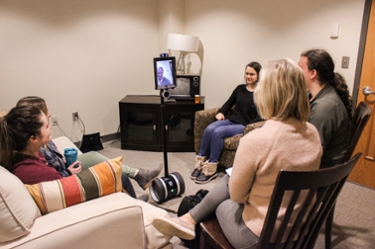Networked Education: Bringing education to you through robotics
Fond du Lac Tribal and Community College and Winona State University
Background
 The state of Minnesota legislated that Fond du Lac Tribal and Community College in Cloquet could grant four-year degrees in elementary education. Winona State University (WSU) and Fond du Lac Tribal and Community College (FDLTCC) entered into an articulation agreement that enables Fond du Lac students to complete their first two years at FDLTCC, then years three and four of a teaching degree as WSU students on the Fond du Lac campus. The courses are unique in that they have co-enrollments, some students in Winona and some in Cloquet.
The state of Minnesota legislated that Fond du Lac Tribal and Community College in Cloquet could grant four-year degrees in elementary education. Winona State University (WSU) and Fond du Lac Tribal and Community College (FDLTCC) entered into an articulation agreement that enables Fond du Lac students to complete their first two years at FDLTCC, then years three and four of a teaching degree as WSU students on the Fond du Lac campus. The courses are unique in that they have co-enrollments, some students in Winona and some in Cloquet.
Because of the distance between campuses, teachers would have traditionally used Interactive Television (ITV) to communicate with the students at the remote site. ITV supports two-way communication using cameras and monitors/projectors at both sites. Communication is live but not entirely engaging: It is difficult to see the people on the other end as they become very small; Group work across ITV is cumbersome.
Using funds from the Mobile Computing Laboratory (McLAB), a previous Innovation Funding project, a Double 2 telepresence robot and a Swivl lecture-capture robot were purchased and sent to FDLTCC. The Double 2 is best described as an iPad on a Segway. It is totally mobile and is controlled over the Internet by a pilot using a laptop or mobile device. Communications are two way, both video and audio. The mobility of the device allows that professor and the students in Winona to move about the room in Cloquet and speak/observe/facilitate/interact with small groups and individual students as if all participants were in the same room. The Swivl is a lecture-capture device which records lectures on an iPad. It rotates automatically to keep the recording device always pointing at the presenter so she/he never leaves the frame. The Swivl was not used in this way at FDLTCC but instead was placed on the table as a two-way communication device during group work. The Swivl would rotate on the table so the viewers on the other end always saw the person talking. An Owl webcam was added for large group work. The Owl shows 360-degree video of the room while providing a close-up of the person that is speaking. This was used in tandem with internet virtual meeting rooms using ACANO and Adobe Connect technologies.
The various robots and cameras became important means to observe student interactions and student engagement with materials and manipulatives, enabling scientific, research-based pedagogical best practices for age-appropriate strategies at each location. Students also benefit by having the opportunity to get authentic conversations with students in different locations and of different cultures around Minnesota regarding course content.
The proof of concept between Winona State University and Fond du Lac Tribal and Community College has been very successful. The professor and the students have all seen the benefit of the increased interactions the robots and cameras provide. Now there has been interest from other colleges to be included in the network.
Type of Grant Received through Minnesota State Innovation Funding
Large Seed Grant - $14,800Telepresence robots in education - Winona State University Technology Knowledge Base
Contact
Minnesota State faculty, staff, and administrators interested in applying for an innovation funding grant can visit the Innovation Funding SharePoint (log in using StarID@MinnState.edu) to find more information and applications.